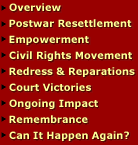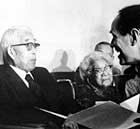



|
SILENCE NO MORE
Silence, forty years of silence
Forty years of anger, pain, helplessness
Shackled in the hearts
Of Issei, Nisei, Kibei.
Many died in silence
Some by their own hands
Some by others.
Today
The survivors
Stood tall, strong, proud
And vowed
No more enryo, giri, gaman.
Today the survivors
Cried out redress, restitution, reparations
Shattering the silence…
- Excerpt from "Silence… No More" by Kiku Funabiki,
From Our Side of the Fence.
Used with permission of author and Japanese Cultural & Community Center of Northern California. © 2001 All rights reserved.
Visit http://ww.jccnc.orgw
|
.jcccnc.or
 
|
 |
 |

 |
|
In the late 1970s, through the persistence of a few Nisei voices and an increasing number of Sansei, the principles of securing a government apology, individual reparations and a public education fund were broadly debated within the Japanese American community.
In 1980, President Jimmy Carter signed legislation to create the Commission on Wartime Relocation and Internment of Civilians (CWRIC). The CWRIC was appointed to conduct an official governmental study of Executive Order 9066, related wartime orders and their impact on Japanese Americans on the West Coast and the Aleutians in the Pribilof Islands.
In 1983, the CWRIC issued its findings in PERSONAL JUSTICE DENIED, concluding that the incarceration of Japanese Americans had not been justified by military necessity.
Rather, the report determined that the decision to incarcerate was based on "race prejudice, war hysteria, and a failure of political leadership." Lastly, the Commission recommended legislative remedies consisting of an official Government apology; redress payments of $20,000 to each of the survivors; and a public education fund to help ensure that this would not happen again.
On August 10, 1988, the Civil Liberties Act of 1988, based on the CWRIC recommendations, was signed into law by President Ronald Reagan. On November 21, 1989, President George Bush signed an appropriation bill authorizing payments to be paid out between 1990 and 1998.
 In 1990, surviving internees began to receive individual redress payments and a letter of apology.
In 1990, surviving internees began to receive individual redress payments and a letter of apology.
 Court Victories Court Victories |
|
|
 |
|
|
|
|
|
 |
Site Overview • Help
World War II & Roundup • Camps Experience • Post War & Impact Today
Home • About the Project • For Educators • Other Resources
Day of Remembrance
Copyright 2001. National Asian American Telecommunications Association. All Rights Reserved.
|
|

